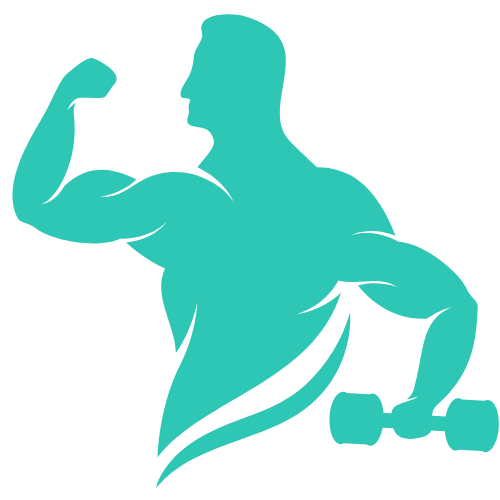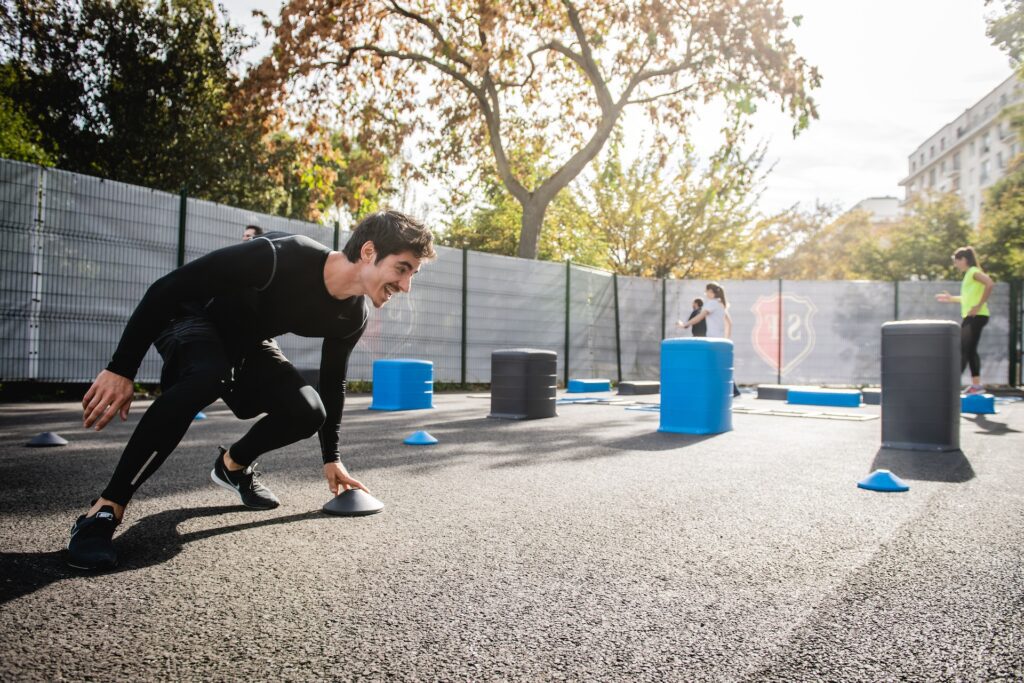5 Best Vertical Pull Exercises for a Stronger, Leaner You

I. Introduction: Vertical Pull Exercises
When striving for a well-rounded and robust upper body, the spotlight often shines brightly on push day exercises, like the classic bench presses and trusty push-ups. Undeniably, these movements play an integral role in building upper-body strength and definition. However, in our relentless pursuit of a sculpted physique, we mustn’t cast a shadow over another equally vital aspect of our workout regimen: pull day exercises.
Picture this: a sculpted back, a defined midsection, and arms that effortlessly carry the telltale signs of strength. That’s the promise that awaits those who embrace the world of vertical pull exercises. In the realm of fitness and wellness, balance is the key to success, and that means balancing your push day efforts with an equally compelling pull day routine.
In this comprehensive guide, we will embark on a journey through the world of vertical pull exercises, unlocking the secrets to a stronger, leaner you. Not only will we shed light on these transformative exercises, but we’ll also delve into the science behind them, unveiling the incredible benefits they offer your body and overall well-being.
So, if you’re ready to sculpt a physique that turns heads, improve your posture, and enhance your overall athleticism, join us on this adventure as we explore the five vertical pull exercises that will take your fitness game to new heights. Say goodbye to the mundane and hello to a body that exudes strength and confidence. It’s time to elevate your fitness journey, one pull at a time.
II. Understanding Vertical Pull Exercises
Vertical pull exercises are a fundamental component of any well-rounded strength and fitness program. These exercises derive their name from the primary motion involved – pulling weight or resistance vertically toward your upper body. By engaging in these movements, you primarily target the muscles in your back, shoulders, and arms. However, the benefits extend far beyond mere muscle engagement.
Muscle Groups Targeted:
Vertical pull exercises place significant emphasis on several muscle groups, making them indispensable for comprehensive upper body development. The primary muscles engaged during these exercises include:
Latissimus Dorsi (Lats): Often referred to as the “wings” of your back, the lats are responsible for the broad and powerful appearance of your upper torso. Vertical pulls, such as pull-ups and lat pulldowns, are particularly effective at targeting the lats.
Trapezius (Traps): These muscles run from the base of your skull down to your mid-back and play a crucial role in shoulder movement and stability. Vertical pulls help sculpt and strengthen the traps.
Rhomboids: Located between the shoulder blades, the rhomboids are vital for maintaining good posture and shoulder health. Vertical pull exercises like cable rows contribute to their development.
Biceps and Forearms: While primarily considered pulling muscles, vertical pull exercises also engage the biceps and forearms to a significant degree. This comprehensive engagement leads to well-rounded upper arm development.
Deltoids (Shoulders): The anterior (front), lateral (side), and posterior (rear) deltoid heads all benefit from vertical pull exercises, contributing to balanced shoulder development.
Balanced Muscle Development:
One of the key advantages of incorporating vertical pull exercises into your workout routine is the promotion of balanced muscle development. Many individuals tend to overemphasize push exercises, such as bench presses and push-ups, which work the chest, triceps, and anterior deltoids. Neglecting the muscles involved in pulling movements can lead to muscle imbalances, poor posture, and an increased risk of injury.
Vertical pull exercises help counteract this by targeting the muscles on the opposite side of the body, ensuring that your back, shoulders, and arms receive the attention they need for symmetry and functionality.
Functional Strength and Posture:
Beyond aesthetics, vertical pull exercises enhance your functional strength and posture. A strong back is essential for everyday activities like lifting, carrying, and maintaining an upright posture. Improved posture, in turn, reduces the risk of chronic back pain and related issues.
Additionally, the strength gained from vertical pulls can translate into improved performance in various sports and activities, making these exercises valuable for athletes and fitness enthusiasts alike.
III. Preparing for Your Vertical Pull Workout
Engaging in a vertical pull workout is an excellent way to target key muscle groups in your upper body, but it’s crucial to approach these exercises with caution and preparation. Before embarking on your routine, it’s essential to adequately warm up and prioritize safety precautions. Here’s a closer look at how to get ready for a safe and effective vertical pull workout:
Warming Up for Success:
A proper warm-up is the foundation of any effective workout routine. It serves to prepare your body for the demands of exercise by gradually increasing your heart rate and circulation, raising your core body temperature, and activating key muscles. For a vertical pull workout, consider the following warm-up strategies:
Dynamic Stretches: Begin with dynamic stretches that mimic the movements you’ll be performing during your workout. Arm swings, shoulder circles, and neck rolls can help loosen up the upper body.
Cardiovascular Activity: Incorporate a few minutes of light cardiovascular exercise to increase blood flow and elevate your heart rate. Jumping jacks, brisk walking, or a brief stint on the stationary bike are excellent options.
Foam Rolling: If you have access to a foam roller, use it to release tension in your upper back, shoulders, and arms. This can help improve flexibility and mobility.
A well-rounded warm-up primes your body for vertical pull exercises, reducing the risk of strains or injuries.
Safety Precautions:
Safety should be your top priority when engaging in any workout, and vertical pull exercises are no exception. Here are some safety precautions to keep in mind:
Equipment Check: Before starting your workout, inspect the equipment you’ll be using, whether it’s a pull-up bar or a cable machine. Ensure it’s stable and in good condition to prevent accidents.
Proper Form: Correct form is critical to both effectiveness and safety. Pay close attention to your form during each exercise to avoid straining your shoulders or back. If you’re unsure about your form, consider seeking guidance from a fitness professional.
Gradual Progression: It’s essential to choose a weight or resistance level that matches your current fitness level. Starting with manageable resistance allows you to learn proper technique and build strength progressively over time. Avoid the temptation to lift too heavy too soon.
By adhering to these safety precautions, you can significantly reduce the risk of injury and ensure a safer, more productive workout.
In summary, preparing for your vertical pull workout involves a comprehensive warm-up routine that includes dynamic stretches, cardiovascular activity, and foam rolling. Additionally, prioritize safety by checking your equipment, maintaining proper form, and gradually progressing in your resistance levels. These measures not only reduce the risk of injury but also enhance the effectiveness of your vertical pull exercises, helping you achieve your fitness goals safely and efficiently.
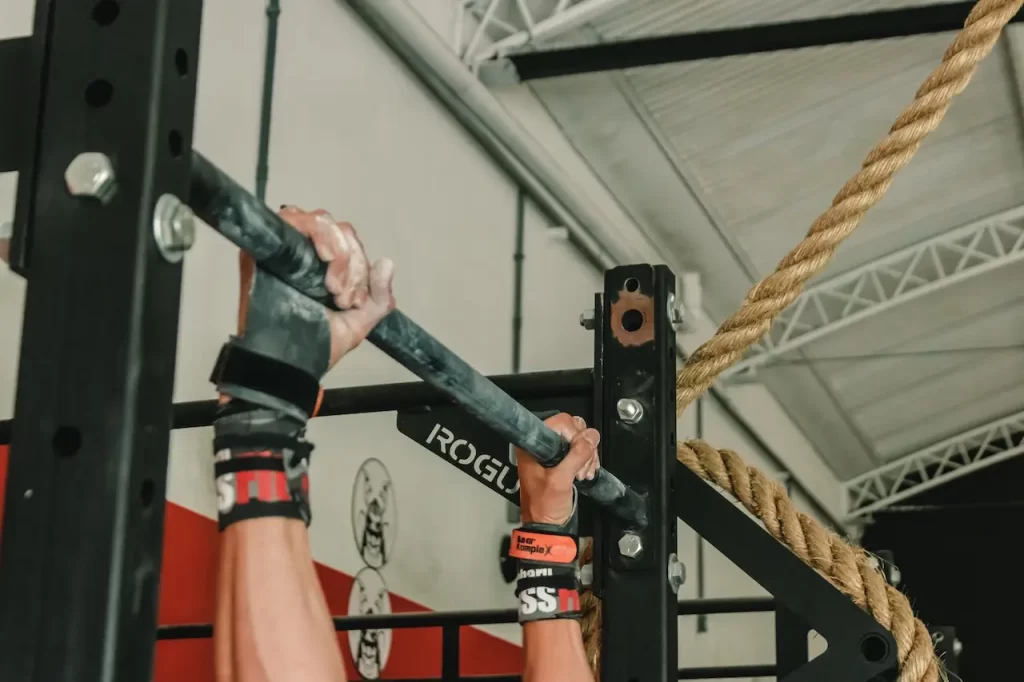
IV. The 5 Essential Vertical Pull Exercises
Now, let’s explore the five powerful vertical pull exercises that can transform your upper body:
1. Pull-Ups
Description: Pull-ups are a classic and highly effective vertical pull exercise that primarily targets your upper back, biceps, and shoulders. This bodyweight exercise involves lifting your body upward by gripping a horizontal bar and engaging your back muscles for a sculpted upper body.
How to Perform Pull-Ups:
- Find a sturdy horizontal pull-up bar with enough overhead clearance.
- Stand beneath the bar and reach up, gripping it with your palms facing away from your body (pronated grip).
- Hang freely with your arms fully extended.
- Engage your back muscles, particularly your lats, and pull your body upward toward the bar.
- Focus on bringing your chest to the bar while keeping your core engaged.
- Lower your body back down in a controlled manner to complete one repetition.
Tip: If you’re new to pull-ups, consider using assistance bands or a pull-up machine to gradually build strength. Proper form is crucial for this exercise, so seek guidance if needed to ensure you perform it correctly.
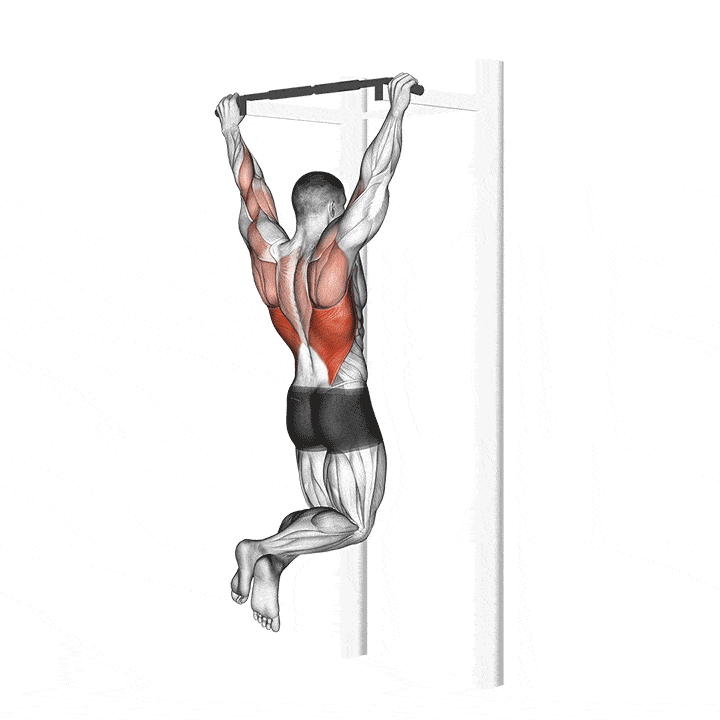
2. Lat Pulldowns
Description: Lat pulldowns are performed on a cable machine and are excellent for targeting the latissimus dorsi muscles (commonly known as the lats). This exercise helps create the coveted V-shaped back by strengthening the muscles responsible for shoulder extension and adduction.
How to Perform Lat Pulldowns:
- Sit down at a lat pulldown machine with your knees secured under the pads.
- Grip the wide bar attached to the cable machine with your palms facing forward.
- Keep your chest up, shoulders back, and a slight arch in your lower back.
- Pull the bar down smoothly toward your chest, focusing on squeezing your shoulder blades together.
- Pause briefly when the bar is close to your chest.
- Slowly release the bar to its initial position to complete one repetition.
Tip: Choose an appropriate weight to maintain proper form and target your lats effectively. Avoid using excessive momentum to pull the weight down.

3. Cable Rows
Description: Cable rows are an essential exercise for building a strong mid and lower back, as well as developing bicep strength. This exercise involves sitting at a cable row machine and using a V-bar attachment to pull the weight toward your torso.
How to Perform Cable Rows:
- Sit down at the cable row machine, gripping the V-bar attachment with your palms facing each other (neutral grip).
- Position your feet on the footplates, and sit with a straight back.
- Begin with your arms fully extended, shoulders relaxed, and a slight bend in your knees.
- Pull the V-bar toward your torso while squeezing your shoulder blades together.
- Pause for a moment when the bar touches your abdomen.
- Slowly release the weight to its starting position to complete one repetition.
Tip: Maintain a controlled tempo throughout the exercise, and avoid using excessive momentum to pull the weight.
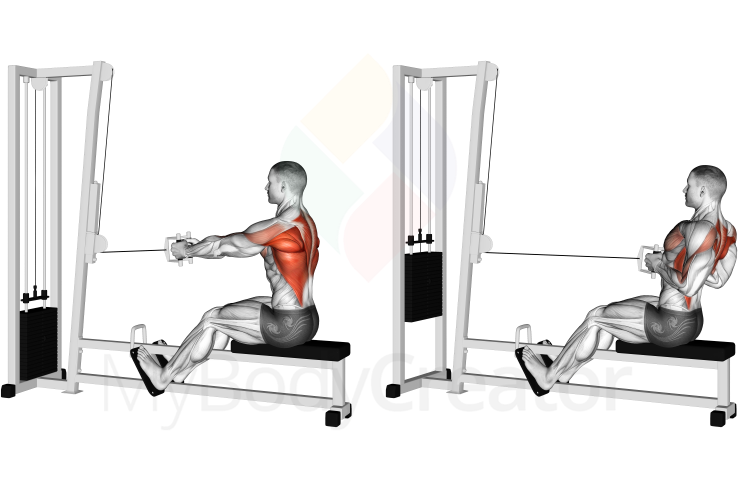
4. Face Pulls
Description: Face pulls are an excellent exercise for strengthening the muscles responsible for good posture and shoulder health. This exercise involves using a rope attachment on a cable machine to pull the rope towards your face.
How to Perform Face Pulls:
- Attach a rope handle to a cable machine at chest height.
- Stand facing the machine and grasp each end of the rope with an overhand grip.
- Take a step back to create tension in the cable, and position your feet shoulder-width apart.
- Pull the rope toward your face, keeping your elbows high and shoulders relaxed.
- Focus on squeezing your shoulder blades together as you pull.
- Hold the position briefly and then slowly release the rope to complete one repetition.
Tip: Adjust the weight on the cable machine to a level that allows you to perform the exercise with proper form and control.
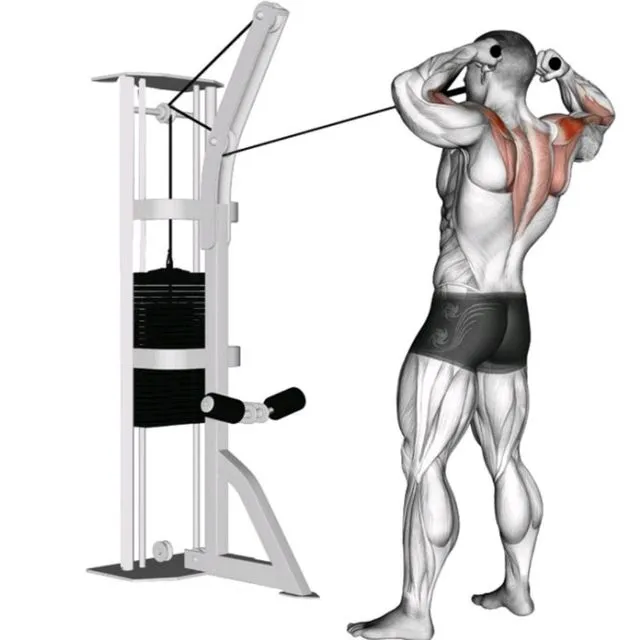
5. Straight-Arm Pulldowns
Description: Straight-arm pulldowns target the lats and triceps and are excellent for enhancing upper body definition. This exercise involves using a straight bar attachment on a cable machine.
How to Perform Straight-Arm Pulldowns:
- Attach a straight bar to a cable machine at the highest setting.
- Stand facing the machine, with your feet shoulder-width apart and a slight bend in your knees.
- Grip the bar with your palms facing down and your arms fully extended.
- Pull the bar downward in front of you while keeping your arms straight.
- Focus on contracting your lats as you pull the bar down.
- Hold the position briefly and then slowly release the bar to complete one repetition.
Tip: Control the weight and avoid using excessive momentum to perform this exercise. Focus on the mind-muscle connection to engage your lats effectively.
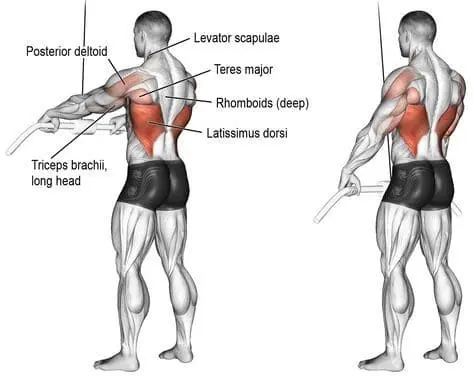
Each of these five vertical pull exercises offers unique benefits for your upper body development. Remember to prioritize proper form and control to maximize the effectiveness of your workout and minimize the risk of injury.
V. Expert Tips and Advice
Achieving the best results from your vertical pull exercises involves more than just going through the motions. To help you get the most out of your workouts and ensure your safety, consider the following expert advice and techniques:
1. Master Proper Form:
Controlled Movements: Concentrate on executing each repetition with control and precision. Avoid using momentum to lift the weight, as this can diminish the effectiveness of the exercise and increase the risk of injury.
Mind-Muscle Connection: Develop a strong mind-muscle connection by focusing on the specific muscle groups you intend to target. Visualize the muscles engaging and working throughout each movement.
Range of Motion: Ensure that you perform each exercise through its full range of motion. This not only optimizes muscle engagement but also promotes joint health and flexibility.
2. Progressive Overload:
Gradual Weight Increase: As your strength and proficiency improve, gradually increase the weight or resistance. This progressive overload is essential for continuous muscle growth and strength development. However, it’s crucial to strike a balance—choose a weight that challenges you without compromising proper form.
Rep and Set Adjustments: To vary your workout intensity, experiment with the number of repetitions and sets. For muscle endurance and toning, opt for higher repetitions (10-15+), and for muscle strength and hypertrophy, use lower repetitions (6-10).
3. Exercise Variations:
Challenge Your Muscles: Introduce exercise variations to your routine periodically. For example, you can change your grip, try unilateral (single-arm) variations, or incorporate isometric holds to add a new dimension to your workout.
Switching Equipment: Utilize different equipment, such as resistance bands, kettlebells, or suspension trainers, to provide your muscles with novel stimuli. These variations can prevent plateaus and keep your workouts exciting.
Vary Your Tempo: Adjust the tempo of your repetitions to change the stimulus on your muscles. For instance, slowing down the eccentric (lowering) phase can increase time under tension, promoting muscle growth.
4. Listen to Your Body:
Rest and Recovery: Adequate rest between workout sessions is vital for muscle recovery and growth. Overtraining can lead to burnout and increased injury risk. Pay attention to your body’s signals and incorporate rest days into your routine.
Nutrition and Hydration: Proper nutrition and hydration play a significant role in your performance and recovery. Ensure you’re fueling your body with the necessary nutrients and staying hydrated to support your workout goals.
5. Seek Professional Guidance:
Consult a Trainer: If you’re new to vertical pull exercises or have specific fitness goals, consider consulting a certified fitness trainer. They can provide personalized guidance, ensure correct form, and design a tailored workout plan.
Physical Assessment: A professional assessment can help identify any imbalances, limitations, or areas that need special attention in your training program. This information can lead to a more effective and safer workout regimen.
By incorporating these expert tips and techniques into your vertical pull exercise routine, you’ll not only maximize the benefits but also minimize the risk of injury. Remember that fitness is a journey, and continual learning and refinement of your workouts will lead to long-term success in achieving a stronger, leaner you.
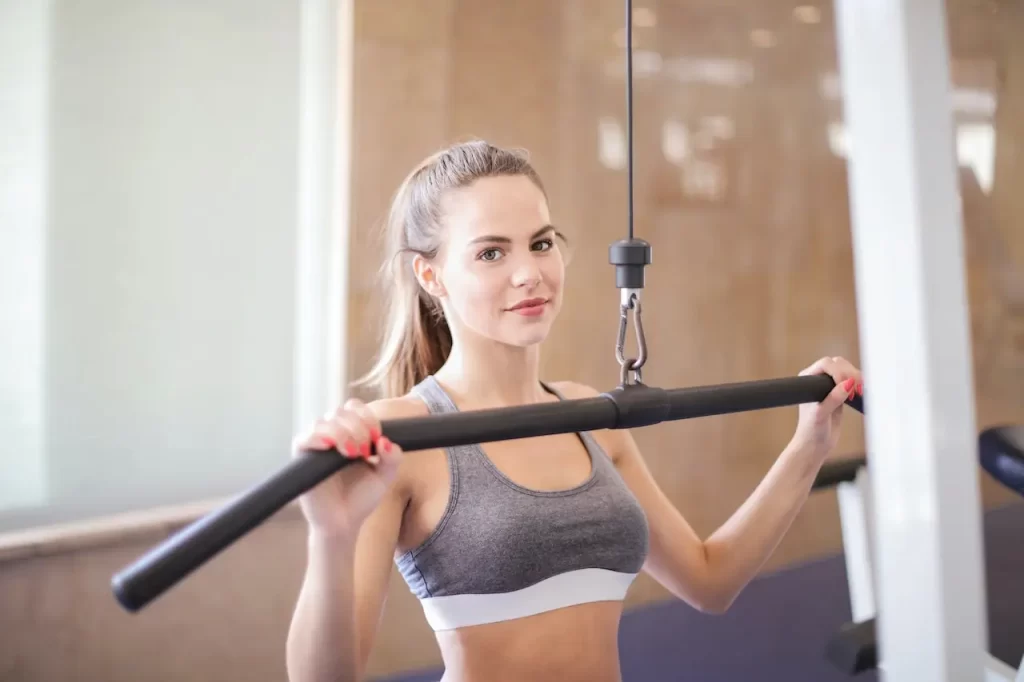
VI. Benefits of Vertical Pull Exercises
The decision to introduce vertical pull exercises into your fitness routine is a strategic step toward achieving a healthier, more robust physique. These exercises, often underappreciated in favor of their pushing counterparts, offer a multitude of benefits that extend beyond just upper body strength.
1. Improved Upper Body Strength:
Vertical pull exercises are the cornerstone of a formidable upper body. By incorporating movements like pull-ups, lat pulldowns, and cable rows, you engage key muscle groups in your back, shoulders, and arms. The result is a significant increase in upper body strength.
Muscle Engagement: These exercises work your latissimus dorsi, trapezius, rhomboids, and biceps, among others. This comprehensive engagement leads to improved muscle definition and functional strength.
Muscle Fiber Recruitment: Vertical pull exercises require the recruitment of both fast-twitch and slow-twitch muscle fibers, making them ideal for both power and endurance development.
2. Better Posture:
Strengthening your back muscles through vertical pull exercises has a profound impact on your posture. The modern sedentary lifestyle often leads to poor posture, which can result in back pain and discomfort. Vertical pulls can help counteract these effects.
Balanced Musculature: A strong back, especially well-developed lats and rhomboids, aids in pulling your shoulders back and down. This naturally aligns your spine and shoulders, promoting an upright and healthy posture.
Reduced Risk of Back Pain: By maintaining proper posture, you can reduce the risk of chronic back pain, which is prevalent in those with weak back muscles and poor posture habits.
3. Balanced Muscle Development:
Achieving a well-proportioned physique is a goal shared by many fitness enthusiasts. Vertical pull exercises play a pivotal role in achieving this balance.
Complementing Push Exercises: While push day exercises like bench presses and push-ups target the chest, shoulders, and triceps, vertical pull exercises target the back, biceps, and shoulders. By incorporating both types of exercises, you ensure balanced development of your upper body.
Visual Symmetry: Balanced muscle development contributes to a visually pleasing physique with proportional muscle groups, enhancing aesthetics and overall body symmetry.
VII. Tracking Progress
Monitoring your progress is a fundamental aspect of any successful fitness journey. Here are some ways to track your push day achievements:
Workout Journal: Keep a detailed journal of your push day workouts, including exercises, weights, repetitions, and sets.
Progress Photos: Regularly take photos to visually track changes in your physique over time.
Strength Metrics: Record your increasing strength in terms of the weights you lift and the number of repetitions you can perform.
Goal Setting: Set achievable goals for your pull day exercises, whether it’s increasing your max rep or mastering a new variation.
VIII. Additional Resources & References
Discover more fitness insights, tips, and workouts by exploring our extensive blog section on our website.
In these articles, you’ll find a wealth of scientific evidence supporting the advantages of incorporating vertical pull exercises into your fitness routine. Here are some key findings from recent studies:
Increased Muscle Mass: A study published in the Journal of Strength and Conditioning Research found that individuals who regularly included vertical pull exercises in their workouts experienced a significant increase in muscle mass, particularly in the back, shoulders, and bices. This muscle growth not only enhances aesthetics but also contributes to overall strength and functional fitness.
Bone Density Improvement: Research from the National Osteoporosis Foundation highlights the role of resistance training, such as vertical pull exercises, in improving bone density.
Cardiovascular Health: Cardiovascular benefits are not limited to aerobic exercises alone. A study published in the American Journal of Cardiology demonstrated that compound exercises like cable rows can elevate heart rate and contribute to cardiovascular health. This suggests that vertical pull exercises can be a valuable addition to your overall fitness regimen.
Posture Enhancement: A study conducted by the American Council on Exercise (ACE) emphasized the positive impact of vertical pull exercises on posture. Strengthening the back and shoulder muscles can help correct rounded shoulders and forward head posture, reducing discomfort and promoting better spinal alignment.
By exploring the articles on our website, you’ll gain access to a comprehensive collection of fitness knowledge backed by these studies and more. These resources are designed to help you and empower you to make informed decisions about your fitness journey.
Incorporating evidence-based information into your fitness routine can lead to more effective workouts and better results. So, dive into our Blog, delve into the research, and take your fitness to new heights.
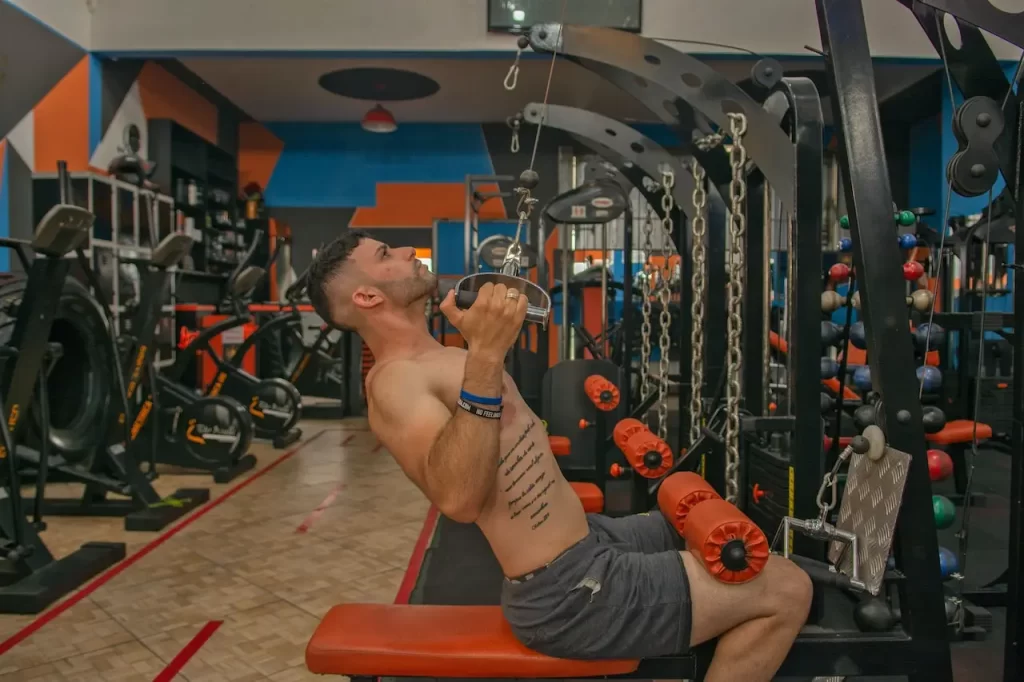
IX. Conclusion
Incorporating vertical pull exercises into your fitness routine is more than a mere addition to your workouts; it’s the key to achieving a stronger, leaner, and healthier upper body. As we wrap up this exploration of vertical pulls, let’s recap the essential takeaways and why you should embrace this effective training approach.
A Path to Strength and Leanness:
Vertical pull exercises stand as a testament to the transformative power of well-structured workouts. They target essential muscle groups in your back, shoulders, and arms, allowing you to build remarkable upper body strength. The benefits go beyond aesthetics, extending to functional strength that enhances your daily life.
The Role of Warm-Up and Technique:
As with any fitness endeavor, the foundation lies in preparation and technique. Proper warm-up routines ensure your body is primed for action, reducing the risk of injury and maximizing your workout’s effectiveness. Coupled with precise form and controlled movements, vertical pull exercises become a potent tool for sculpting your physique.
Consistency is Key:
Consistency is the secret ingredient to success in fitness. To unlock the full potential of vertical pull exercises, commit to a consistent workout regimen. Consistency not only builds muscle but also reinforces proper form and gradually increases your strength and endurance.
A Journey to Health and Wellness:
Vertical pulls offer a holistic approach to wellness. They promote better posture, reducing the risk of chronic back pain that plagues many individuals. Furthermore, balanced muscle development is achieved by harmonizing vertical pull exercises with pushing movements, resulting in a well-rounded and visually pleasing physique.
Embrace the Challenge:
Vertical pull exercises are not without their challenges, but it’s within these challenges that your body and mind grow. As you embark on this journey, you’ll discover that each pull-up, lat pulldown, or cable row is an opportunity to surpass your limits and reach new heights of strength and fitness.
In conclusion, your path to a stronger, leaner you starts with embracing the world of vertical pull exercises. With dedication, consistency, and a commitment to proper form, you’ll unlock the full potential of these exercises and experience the remarkable physical benefits they offer. So, don’t hesitate; embark on this empowering journey today, and witness the transformation of your upper body and overall well-being. Your future self will thank you for it.
